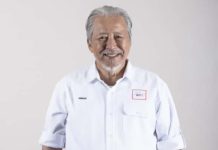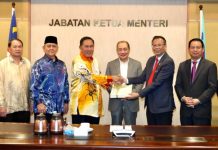KOTA KINABALU: Fresh calls are being made to revisit the concept of East Asean cooperation and greater coordination and cooperation between the territories. East Asean comprises Brunei, Indonesia, Malaysia and Philippines, thus the BIMP acronym.
They formed a growth polygon in 1994 that has come to be known as BIMP-EAGA. EAGA stands for East Asean Growth Area. Except for Brunei which is in EAGA as a sovereign
nation, the other countries only have their territories in EAGA is members.
There are also calls to strengthen, consolidate ties between the four East Asean governments, and for these central governments to accord appropriate national government attention on EAGA in order to gain optimum economic returns from the territories.
But, after almost 30 years, the economic data of Indonesia, Malaysia and Philippines still show clear growth disparity between their territories in EAGA and the national averages.
“This fact alone shows there is a need of synergistic efforts by the central and territorial governments to revisit the original BIMP EAGA concept of mutual cooperation for mutual prosperity and consider a collective approach to marketing ourselves as a single EAGA entity,” said the Chairman of the BIMP- EAGA Business Council (BEBC), Malaysia (Sabah), Dr Raymond Alfred. Dr Alfred, who currently headed a research and certification group, who was previously served as a Senior Technical Advisor to the office of Sabah’s Special Envoy to BIMP EAGA, was appointed to the BEBC on 1st September 2023.
The Council has since appointed 12 key panel advisors to enable it to meaningfully contribute to development in specific economic sectors.
Dr Alfred felt that with 19.4% of the respective national population, 17.9% of
the GDP, EAGA affairs deserve the attention of the central govts of especially
Indonesia, Malaysia, and the Philippines.
“Sadly though, Jakarta, Putrajaya (Kuala Lumpur) and Manila had largely considered EAGA as incidental. I think EAGA’s economic numbers should earn them the deserved attention.”
“With Indonesia moving its national capital to East Kalimantan (this provinces is within EAGA) next year, the rapidly improving global connectivity, the impact of China’s growth and the BRI (Belt & Road Initiative) it sponsors andthe global sourcing of resources, EAGA’s time has come.
“We must first recognise this fact and go about figuring how to position ourselves, and at the same time we need to make sure the basic infra such as power, energy, water and road is well placed to support the future industrial and commercial activities, especially in well managed ports.”
He outlined notable economic data of BIMP-EAGA:
– 1.6 million sq km – 62.4 % of BIMP’a total land area
– 18.2% of BIMP’s labour force
– 79.8 million population (2021) – 19.4% of BIMP’s overall population
– EAGA’s combined GDP was US$323.1 billion – 17.9% of BIMP total
– Trading volume US$95.3 billion – 19.1% of BIMP total
"This is the basis for my calling to rally every stakeholder, from state and
provincial to federal governments, thinkers, policy, bankers and investors, to
consider our best options and strategies."
In this context, Dr Alfred noted recent narratives of Sabah leaders and officials that revealed their awareness of EAGA’s collective potential and the importance of leveraging Sabah’s strategic geographical position within.
“The Sabah Chief Minister, Datuk Seri Panglima Haji Hajiji bin Haji Noor, recently mooted the Blue Economy alluding to the potentials of the maritime industry. This brings to the fore the fact that the bulk of Sabah’s resources in that sector lies in the waters in Eastern Sabah, where the marine landscape in BIMP EAGA’s economic corridor shared actively between Malaysia (Sabah) and Philippines (Mindanao and Pahlawan), and I can see how POIC can play a major role in a BIMP EAGA economic corridor.”
The recent Memorandum of Understanding between BEBC Malaysia (Sabah) and BEBC Palawan during the 4th PEDCO BEBC Business and Tourism Forum, which was recently held in Puerto Princesa, Palawan from 19th to 22nd January 2024, focuses on the development of:
1. Renewable Energy to support Industrial Development
2. Blue Economy Synchronization Programme
3. Cultural-Based Tourism Exchange Programme integrated Sabah-Palawan, with relevant high Institutions or universities.
4. Halal Business Certification Programme, Hub Centre, and AI Matching System Development
A Proof of Concept for ‘Blue Economy’ will be initiated by BEBC Malaysia (Sabah) with the support from Advanced Machine Intelligence Research Group, Universiti Malaysia Sabah, Malaysia. Oceans are increasingly gaining in importance in terms of enabling international trade via linking sellers and buyers.
The behaviour patterns of such linking enablers on the oceans are receiving more attention from a regulatory and economic perspective as the relationship between land and ocean evolves in its role and importance.
Dr Alfred said POIC Lahad Datu has the potential to become the central of the Blue Economy – Proof of Concept. Blue Economy presents significant challenges at an economic, social, and environmental level, which is why the Blue Growth strategy is considered as the key piece of the puzzle to guarantee environmental sustainability and efficient management of the seas and oceans’ resources.
In this context, the SDGs imply that economic development is both inclusive and respectful of the environment, and it is necessary to find a balance between economic, social and environmental spaces.
For example, one cannot consider eradicating poverty without guaranteeing the health of ocean ecosystems that are fundamental to food security, livelihoods, and economic development. Therefore, it is urgent to set goals with objectives and indicators that demand productive, healthy, and resilient oceans.

The above map shows the Boundary of the Proof of Concept (PoC) for the Blue Economy Programme. Lahad Datu, Semporna, Tawau, Bongao, General Santos, Pagadian, Zamboanga, Puerto Princesa, Bataraza, Kudat and Sandakan, will become the member of the PoC for Blue Economic Programme.
This area may cover at least 30% of the Sulu Sulawesi Marine Ecoregion and 15% of the Coral Triangle Initiative. The marine conservation programme is already in place, but we need to integrate the parameter on Blue Economy, Blue Growth and Circular Economic trend to ensure a balance business operation can address the economic, social, and environmental issues.
However, to reduce the risks and enhance security purposes, Dr Alfred would like to recommend only POIC, Lahad Datu and Kudat to be accessible for international shipping, to ease the monitoring of the trading and other commercial-business related matters. By limiting only 2 seaports can be accessed in the eastern coastline area, the security and surveillance of illegal activity could be improved and operated with smooth and consistent by ESSCOM.
Dr Alfred added that the services of shipping-ferry (M/V Cattleya) services that is currently provided by PT Pacak Samudra, led by Pak Rudy Affendy, from Tanjung Selopo to Lahad Datu, will be planned to be extended to Palawan (transit at Kudat, if there is any needs) in the next 6-12 months as a follow up action from the recent MOU between BEBC Malaysia (Sabah) and PT Pacak Samudra. This could further strengthen the connectivity of this Blue Economy – Proof of Concept in Sabah, where POIC has the potential to become the
main central of Blue Economy Centralise City soon.
“Hajiji’s government has identified Sabah’s East coast as our new economic growth hub and this part of Sabah is smack in the middle of EAGA with untold potentials.”
“The recent arrival in Lahad Datu of the M/V Prince Khalil passenger ferry from Bongoa (Philipines) last September and M/V Cathleya Express in December demonstrated the East Coast marine landscape will be a key part of the new economic growth hub,” Dr Alfred added, and noted plans in the works to begin ferry services between Lahad Datu and Tawi Tawi in Philippines and Sulawesi in Indonesia.
These formal channels of passenger movements will put in place a mechanism that will discourage illegal immigration and regulate flow of migrant workers.
Dr Alfred revealed that one of BEBC’s initiatives will focus on working with ESSCOM (Eastern Sabah Security Command) and owners of oil palm plantations, timber operations and tourism operators to develop a database for immigrant workers, and make sure all the plantation, timber, tourism and other labour-related industries can reach “Zero Illegal Workers” by phases.
This is a step towards ensuring that every immigrant worker is in possession of valid
work permits.
The oil palm plantations, timber operations and tourism operators should show the best example in business operation and to meet the SDGs. The Sustainable Development Goals (SDGs), also known as the Global Goals, were adopted by the United Nations in 2015 as a universal call to action to end poverty, protect the planet, and ensure that by 2030 all people enjoy peace and prosperity.
“This measure will, we hope, have an impact in addressing investors’ concern about security and the validity of foreign workers.”
He also referred to a recent remark by Minister of Agriculture and Food Industries Datuk Dr Jeffrey Kitingan about Sabah’s potential as a hub for China’s Belt and Road (BRI) initiatives in ASEAN.
“The minister talked about Sabah’s potential. I’d like to imagine the potentials of the EAGA region we are in, how attractive our combined resources and logistics potentials are to the global investors.”
Dr Alfred, who also has expertise in supply chain management, also alluded to a plan by state owned POIC Sabah Sdn Bhd to develop POIC Lahad Datu as a logistics and manufacturing hub for BIMP EAGA.
“There isn’t an industrial park and a port of such standard in the region. If EAGA governments recognised this and allow the amalgamation of raw materials – palm oil, biomass, cocoa, birds’ nests, seaweed, fishery resources – for value added manufacturing, we will create a win-win equation for the whole region.”
“I thought that it is a brilliant idea for a few reasons. For one, POIC Lahad Datu industrial park is matured, and it operates a comprehensive set of ports that are globally connected.”
Dr Alfred has recently visited POIC and had an in-depth briefing by its Group Chief Executive Officer, Datuk Fredian Gan and Deputy Chief Executive Officer, Lynette Hoo.
While revealing that he has industry players exploring solar energy production integrated with desalination in Lahad Datu, he praised POIC for its awareness and unceasing efforts in upgrading its infrastructure to add to its attractiveness. Dr Alfred said that the Renewable Energy Solar Power Plant (with Capacity 50-100 MW) could be a future potential programme (JV programme between BEBC Malaysia, Sabah and POIC) to further support
POIC to enhance the SDGs’s target and at the same time to further help the Government of Sabah to achieve its goals in Sabah Energy Roadmap and Master Plan 2040 and its goals in the BIMP EAGA programme, in the contexts of development of power and energy using renewable energy.
Dr Alfred said that he is in the final stage dealing with potential investors to establish Solar
Power Plant in POIC, Lahad Datu. The concept of the project is Private (PFI) Finance Initiative Schedme. PFI is a scheme to support the government’s efforts (especially SESB) to improve the quality of services of public facilities, especially energy generation and supply. I believe the energy security is the key of the social and economic growth in BIMP EAGA.
“BIMP EAGA came about because the leaders back then didn’t want distance (between national capitals and EAGA territories) to be a hindrance to progress, we as stakeholders must work at getting the support of the central governments, and at the same time assert ourselves strongly and collectively.”
With the blue economy integration, adapting the renewable energy as key energy sources, effort to fulfill, measures or compliance with Sustainable Development Goals (SDGs), I believe POIC, Lahad Datu can go further to become the Best Green Port in Malaysia and in BIMP EAGA Region.-pr/BNN






